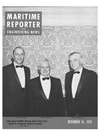
Page 11: of Maritime Reporter Magazine (December 15, 1970)
Read this page in Pdf, Flash or Html5 edition of December 15, 1970 Maritime Reporter Magazine
TWO FOR UNION CARBIDE: The first of two 600,000- gallon pressure tank inland barges being built for the
Union Carbide Corporation was launched recently from
Bethlehem Steel's Beaumont, Texas shipyard. The Beth- lehem-designed barge has a length of 180 feet, beam of 52 feet 6 inches, depth of 12 feet 6 inches and loaded draft of approximately 8 feet 6 inches. The two cylindrical, independent pressure tanks are equipped with hemispherical heads and are suitable for the trans- portation of butadiene, propane or propylene. The barge was launched from the yard's new production-line barge- building facility. Tanks and piping of both barges are being built in accordance with applicable U.S. Coast
Guard regulations and under Coast Guard inspection.
They are also being built in accordance with the Amer- ican Bureau of Shipping rules for longitudinally framed barges for inland waterways and will be classed A-l pressure tank barges.
Lloyd's Register Studies
New Type Containership
Lloyd's Register of Shipping has recently com- pleted a research study into a projected type of full cellular containership intended to carry 10 containers abreast underdeck and to be able to pass through the Panama Canal.
The research study was carried out in coopera- tion with the Dutch Nedlloyd Consortium which comprises the containership interests of Konink- lijke Rotterdamsche Lloyd. Stoomvaart Maat- schappij "Nederland" and Vereenigde Neder- landsche Scheepvaart Maatschappij, and it con- cerned two ships of the new type which Ned- lloyd has ordered to Lloyd's Register class at
Bremer Vulkan Schiffbau & Maschinenfabrik. In all, Lloyd's Register has so far been asked to class 17 of the new generation of ships now on order. Measuring about 940-feet overall by 106- feet maximum beam by 82-feet depth, they will be far larger than the present generation of large containerships, having a deadweight of about 40,000 tons and being equivalent in size to bulk carriers of more than 100,000 deadweight tons.
Due to the width limitation of the Panama
Canal, the ships' breadth will be limited to 106 feet. The carriage of 10 containers abreast, how- ever, requires a hatch width of more than 89 feet, leaving less than 15 percent of the ships' breadth available for deck width and double-skin side structure. This is considerably less than the already small percentage breadth available on the current generation of containerships which carry only nine containers abreast, and a very de- tailed analysis was required to ensure that the new ships would have sufficient structural strength. In addition, the design finally adopted resulted in a deeper ship than the large container- ships currently in service, enabling more con- tainers to be carried below deck.
Part of the study was carried out at Lloyd's
Register's research laboratory by means of two plastic models. Made of "Cobex" rigid P.V.C. sheet, the models represent a projected ten- abreast and a conventional nine-abreast ship.
Their structural behavior was determined by loadings applied in a steel testing frame, and various structural features influencing the tor- sional behavior were compared. Pure torque load was applied through weights hung from loading beams, and twisting and warping deformations were measured by deflection gages located at a number of positions along the models. By taking measurements at increments of load, the Society's research staff were able to build up a comprehen- sive picture of the load/distortion relationship.
Distortion of the hatches was measured by intern- al micrometers across the hatch diagonals. By the application of standard techniques, the behavior of the projected type of containership at sea was predicted from the model.
The results of the model work showed that the projected hull, with narrow deck and side walls and with deeper draft, would be as efficient struc- turally as the nine-abreast ships now in service, and further, they correlated well with the results of present analytical methods. It was also shown that a two-thirds aft machinery space would re- duce torsional twisting of the hull considerably, compared to the full aft configuration now popu- lar, and that the presence of the superstructure above would reduce twisting still further. The scantlings of both machinery space and super- structure would have to be designed specifically to have this effect.
A complementary analysis using finite element techniques was made to investigate the behavior of transverse deck panels between hatches in re- ducing hatch corner stresses. The analysis showed that relatively narrow panels would be more ef- fective than wide ones due to the fact that wider members, being less flexible, produce higher stress concentrations at the hatch corners. It was further found that the necessary torsional strength would be provided by the adoption of a narrow under- deck box girder between hatchways in association with corresponding bottom and side structures to form a box ring around the hold bulkheads.
The study required the use of Lloyd's Regis- ter's computer programs, L.R. 200 and L.R. 263.
They are the Society's standard programs for cal- culating torsional properties of sections and eval- uating twist, warping and stress distributions along the length of cellular containerships.
Beliard Murdoch S.A.
Kattendijkdok Westkaai 21 • Antwerp, Belgium
U.S.A. Representative -
Robert M. Catharine Jr. 11 Broadway, New York 10004 (212) 944-6050
For the finest in complete shipbuilding and ship repair facilities
Beliand Murdoch antwerp
Two privately owned graving docks up to 90,000 DWT capacity
Ten city owned d.-ydocks also available 24 hour pierside service 5 complete new machine shops
Heaviest and precise engineering work
Diesel servicing—
Gotaverken—M.A.N.—Doxford
December 15, 1970 13

 10
10

 12
12
